SUMMARY
This research looks at the various factors that affect image appearance of a target in microwave and radar frequencies. To better understand how to implement unconventional countermeasures, it is important to understand the physical and material properties that affect target detection, recognition, and identification in intelligence, surveillance, and reconnaissance (ISR) missions. The research was conducted through a basic understanding of material properties and electromagnetic radiation. A deeper understanding of the material properties—to include atomic structures of materials, dipole moment, polarization, and permittivity—is also discussed. Current research has shown that the relative permittivity of a material plays a significant role in how that material interacts with certain electromagnetic radiation; thus, the various factors affecting permittivity are also discussed. This research attempts to identify material property characteristics that can be introduced into models that will lead to a better understanding of the image appearances of targets in microwave and radar frequencies.
INTRODUCTION
Synthetic aperture radar (SAR) was developed in the 1950s as a tool for the U.S. Army to conduct 24-hour surveillance in all weather conditions. SAR’s ability to penetrate clouds and fog made it a naturally effective surveillance tool. Modern SAR systems utilize computer processing to detect and recognize target signatures in collected data. SAR operates in the radio and microwave regions of the electromagnetic (EM) spectrum [1]. A depiction of EM frequency ranges is shown in Figure 1.
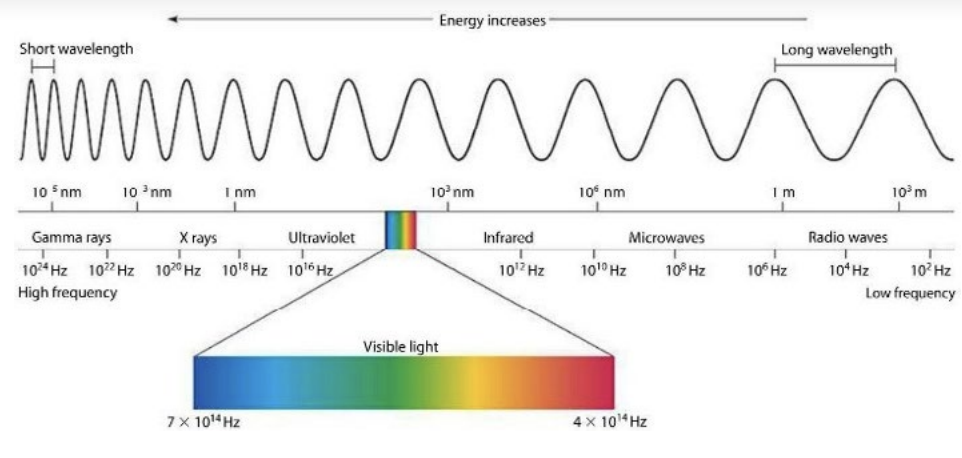
Figure 1: EM Spectrum (Source: The Electromagnetic Spectrum [1])
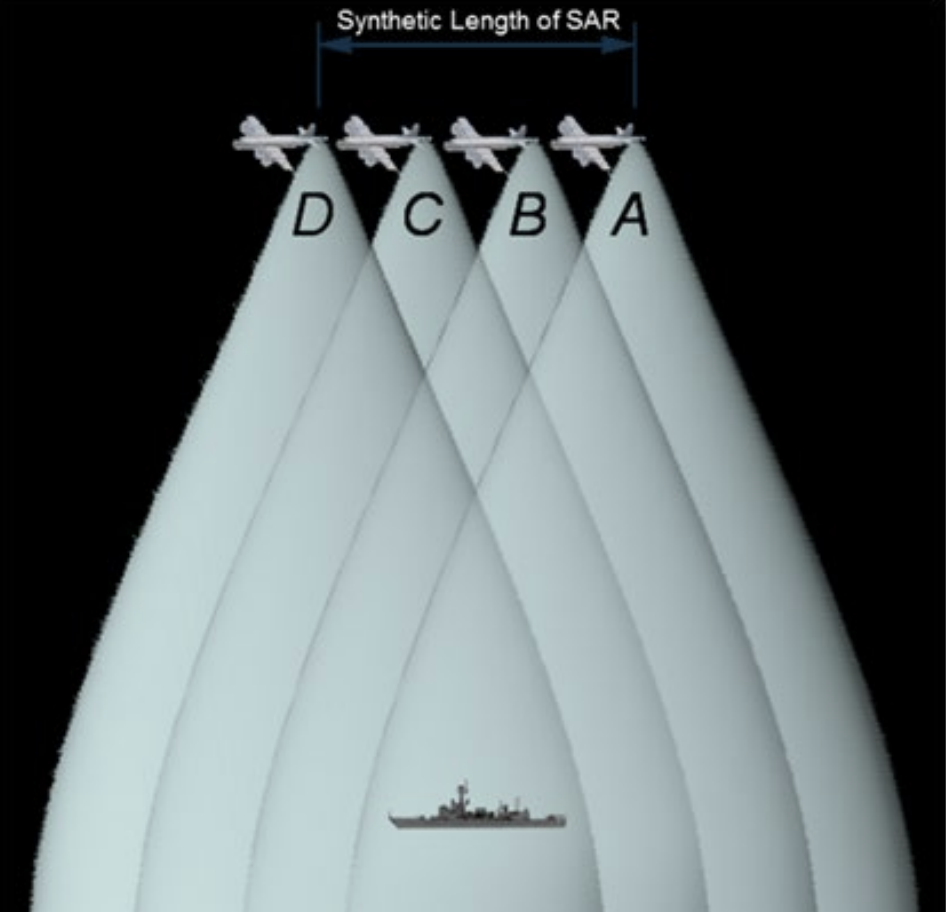
Figure 2: Example of SAR Collection From Airborne Asset (Source: Wolff [2]).
FACTORS AFFECTING SAR
SAR can provide images day and night and penetrate dust, fog, smoke, and other atmospheric obstructions [3]. This versatile capability provides target imagery in conditions where other electromagnetic sensors, such as visual and infrared (IR), are precluded. SAR operates by transmitting EM waves toward a target and receiving the waves reflected back to the receiver. Factors that affect radar return from the target include surface roughness, radar viewing angle and surface geometry, and material properties of the target [3]. The temperature of a material also has an effect on the way an object of a certain material type or composite of materials will appear in SAR imagery [4]. As the temperature increases, polarization of the material decreases; thus, the dielectric constant of the material decreases. More energy is required from the incoming electromagnetic waves to polarize the material, which means more energy is absorbed, less energy is reflected, and the material has a darker tone in SAR imagery. On the atomic level, polarization and dipole moment of the material have a sizable effect on SAR signatures within a scene [5].
Surface Roughness
Figure 3a depicts surface roughness, which is determined by the incident angle of the incoming EM wave and its wavelength [6]. For a smooth surface, the relationship between the incident angle and the wavelength is given by the Fraunhofer criterion 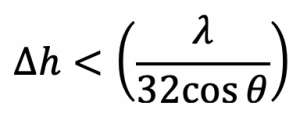 or the Rayleigh criteria
or the Rayleigh criteria 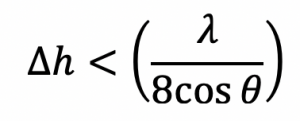 [7]. A smooth surface will have specular reflection (i.e., most of the EM waves will be reflected away from the radar receiver). Such a surface will appear as a dark tone in a radar image.
[7]. A smooth surface will have specular reflection (i.e., most of the EM waves will be reflected away from the radar receiver). Such a surface will appear as a dark tone in a radar image.
A rough surface is one that does not meet the Fraunhofer criterion or Rayleigh criteria and will cause diffuse reflection of the incoming waves. Diffuse reflection causes the EM waves to reflect in all directions, which means more of the transmitted waves return to the radar receiver. This results in a brighter tone of the target relative to its surroundings in the radar image.
Corner reflections occur when man-made or natural features have two or more surfaces (usually smooth) at right angles to each other and the corner faces in the general direction of the radar antenna. This right angle surface orientation causes most of the transmitted waves to reflect directly back to the antenna due to double or multipath reflections, which results in brighter targets in radar images [6]. Some examples of corner reflection are buildings, streets, bridges, cliff faces, and upright vegetation standing in water [8].
Radar Viewing Angle and Surface Geometry
Figure 3b shows radar viewing and surface geometry that account for the local incident angle (A), which is the angle between the EM wave and a line perpendicular to the slope at the point of incidence, and the look angle (B), which is the angle between the vertical plane passing through the radar antenna and the line between the antenna and target. If A is equal to B, then the resulting reflection is specular, resulting in darker image tones. For slopes facing toward the radar, if A is not equal to B, the reflected waves are strongly backscattered, resulting in a bright image tone.
The orientation of the transmitted radar beam relative to the direction or alignment of linear features on the surface is described by the look direction and depicted in Figure 3c. A nearly perpendicular orientation of the look direction to the feature (shown by look direction angle A) will cause a large portion of the incident wave to reflect back to the sensor, and the feature will appear brighter. An oblique orientation of the look direction to the feature (shown by look direction angle B) will cause a small portion of the incident wave to reflect to the radar, and the feature will appear darker in tone [6].
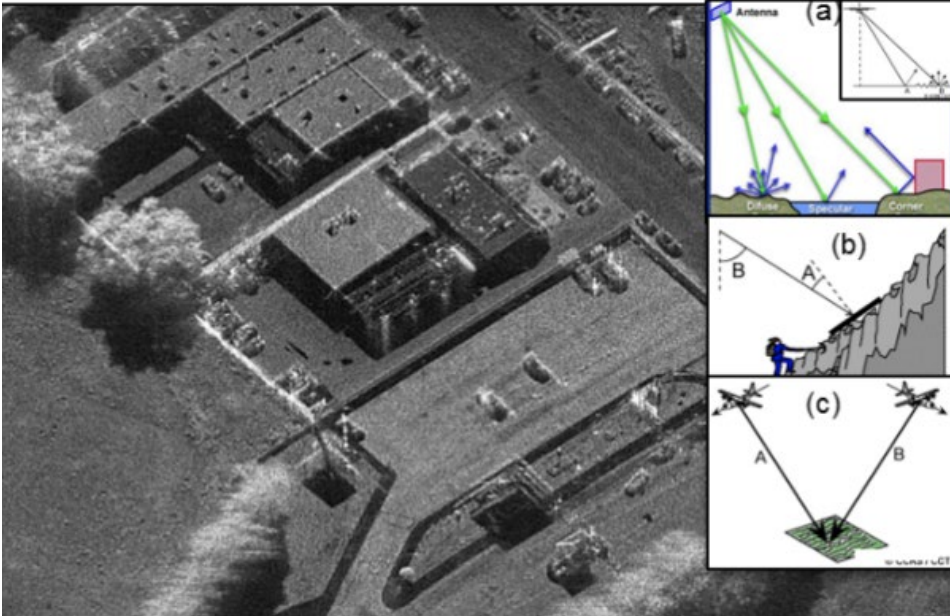
Figure 3: Effects of (a) Surface Roughness, (b) Viewing Angle and Surface Geometry, and (c) Orientation (Sources: Natural Resources Canada [6] and Charvat [9]).
Target material properties play a major role in that target’s SAR imagery. These properties include relative permittivity (dielectric constant) and permeability of the material. Absolute permittivity of the material describes the resistance of a material to set up an internal electric field in the material in the presence of an external electric field. Relative permittivity is the permittivity of a material relative to the permittivity of a vacuum (εr) [10]. Permeability describes the ability of a material to support the formation of a magnetic field inside the material. Along with these intrinsic properties, the thickness of the material, the radar frequency, and the transmitted wave’s incident angle greatly affect how the material appears in SAR imagery [11]. Together, these factors define the complex refractive index and absorption loss that an incoming wave will experience as it propagates through the material.
The Fresnel equations shown in Table 1 define the ratio of the reflected wave and the transmitted wave to the incident wave for the perpendicular and parallel components of the electric field. These equations utilize the complex refractive index given by (1) , where ñ is the complex refractive index determined by the material refractive index
, where ñ is the complex refractive index determined by the material refractive index 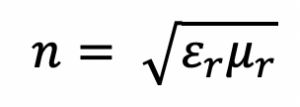 , and (2) absorption loss (also known as extinction coefficient)
, and (2) absorption loss (also known as extinction coefficient)  , where
, where 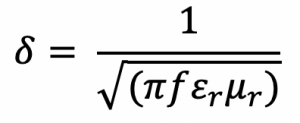 and determines the ratio of the reflected waves from an object and transmitted waves through the object. The material relative permittivity (εr), relative permeability (μr), and frequency of the incoming electromagnetic radiation (f) affect the refractive material index, which affects the reflected and transmitted radiation according to the Fresnel equations [12]. The effects of these factors define how much of the incident wave is reflected back to the radar, which determines how bright or dark the target appears compared to its surroundings.
and determines the ratio of the reflected waves from an object and transmitted waves through the object. The material relative permittivity (εr), relative permeability (μr), and frequency of the incoming electromagnetic radiation (f) affect the refractive material index, which affects the reflected and transmitted radiation according to the Fresnel equations [12]. The effects of these factors define how much of the incident wave is reflected back to the radar, which determines how bright or dark the target appears compared to its surroundings.

Table 1: Fresnel Equations
PROPERTIES
Material Bond Types
At the atomic level, the type of chemical bonds in a material affects polarization and dipole moment, which, in turn, affects the material’s relative permittivity. Relative permittivity and permeability have a great effect on the complex refractive index of a material. Polar bonds form between two nonmetallic elements and have molecules with large dipole moments (e.g., hydrochloric acid [HCL] and water [H2O]). Nonpolar bonds form between two nonmetallic elements and have molecules with very small or no dipole moments (e.g., carbon dioxide [CO2] and methane [CH4] [13]). Ionic bonds form between metals and nonmetals (e.g., sodium bromide [NaCl] and calcium chloride [CaCl2] [14]). Metallic bonds occur between atoms of a metal. Attraction between one atom’s nucleus and a neighboring atom’s electrons packs the atoms closely together. This arrangement allows electrons to move freely from one atom to another. This subsequently makes metals good conductors, as they possess free-flowing electrons. Figure 4 shows the general arrangements of atoms and/or molecules in solids, liquids, and gases [15].
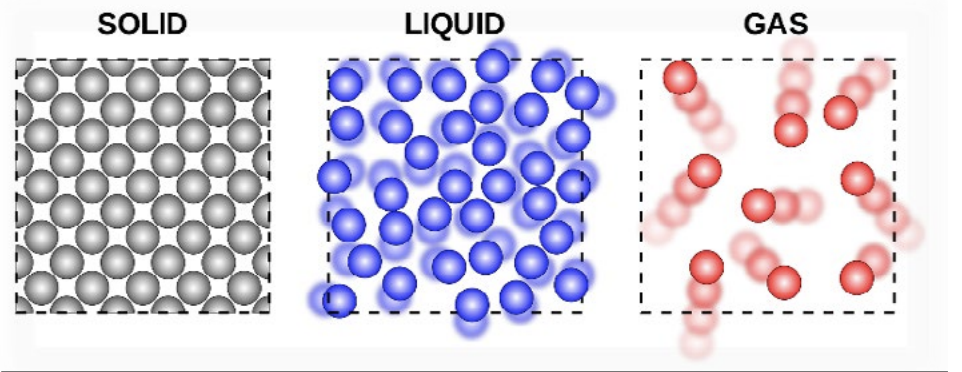
Figure 4: Example of Atomic Distribution in Solids, Liquids, and Gases (Source: Wikipedia [16]).
Polarization expresses the density of permanent or induced electric dipole moments in a dielectric material [17]. When an external electric field is applied to a material, it causes a displacement of bound, charged elements. These elements are not free to move about the material. As a result, the positively charged elements are displaced in the direction of the applied electric field, while the negatively charged elements are displaced opposite the direction of the applied electric field. The molecule as a whole may remain neutral in charge, yet an electric dipole moment is formed. So a stronger dipole moment results in a stronger molecular resistance to rotation, and, hence, more energy is required to rotate the molecules. Such a material would absorb much more energy. Figure 5 shows different stages of polarization in a material [18].
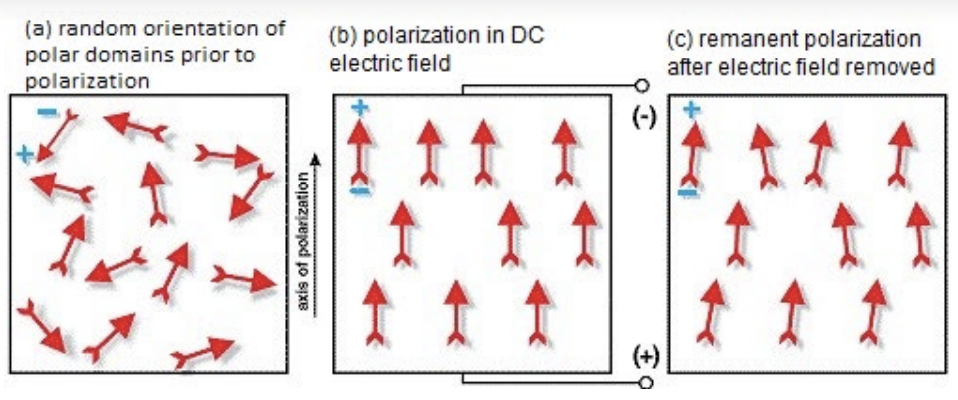
Figure 5: Atomic/Molecular Polarization in Response to External EM Field (Source: Asztalos [19]).
The effect an applied electric field on a material is described by its permittivity. Higher permittivity tends to reduce any electric field set up in the material. The relative permittivity (dielectric constant) of a material is the ratio of the permittivity of the material to the permittivity of a vacuum. A material will have a greater dielectric constant with greater polarization developed in the material [20].
TYPES OF POLARIZATION
Electronic Polarization
Electronic polarization occurs when a neutral atom is subjected to an external electric field. The charges are redistributed, and the electrons shift from equilibrium with respect to the positive nuclei. This reorientation results in an induced dipole moment. In crystalline elements comprised of covalent (molecular) bonds, the valence electrons in these bonds are easily shifted compared to the rigid ionic cores when subjected to an external electric field. This type of polarization is responsible for large dielectric constants, such as silicon with a relative permittivity of 11.9 and germanium with a relative permittivity of 16 [18].
Atomic or Ionic Polarization
Atomic or ionic polarization is due to the relative displacements of the atoms or ions within molecules and crystal structures from their equilibrium states. Examples of atomic or ionic polarization include potassium fluoride (KF) and potassium chloride (KCl) [18].
Orientation or Dipolar Polarization
Orientation or dipolar polarization occurs in materials with molecules that contain permanent dipole moments, such as water and hydrogen chloride. When no external electric field is applied to such materials, the molecules are randomly oriented due to thermal activation. This produces no net dipole moment. In the presence of an applied external electric field, random (polar) molecules with permanent dipoles try to align parallel to the electric field. Under certain frequencies, the dipoles respond to the alternating electric field by rotating to align with the external electric field. The dipoles are unable to align themselves with the external electric field in sufficient time, creating a phase difference between the orientation of the electric field and the dipoles. This phase difference causes molecular collisions and releases energy in the form of dielectric heating [18].
Interfacial (Maxwell-Wagner) Polarization
Interfacial (Maxwell-Wagner) polarization, also known as space charge polarization, is due to the accumulation of free charges at interfaces located within the material or between different materials. In the absence of an external electric field, the material has equal numbers of positive and negative ions; therefore, there are no charge separations between the opposing ions. Mobile charges accumulate at barriers, such as grain/phase boundaries, or at free surfaces in the presence of an external electric field. This results in interfacial polarization. Figure 6 depicts the different kinds of polarization as described in Gupta and Wong Wai Leong [18].

Figure 6: Types of Polarization (Source: Gupta and Wong Wai Leong [18])
Polarization is frequency dependent. Due to their small mass, electrons have little inertia and can follow the alternating electric fields up to high frequencies in the visible light portion of the EM spectrum. Electronic polarization can occur almost in phase with an electromagnetic field and does not generally contribute to microwave absorption by the material. Atomic or ionic polarization is dependent on available thermal energy. This energy corresponds to frequencies in the IR region. Such polarization can also occur in phase with the electromagnetic field and does not generally contribute to microwave absorption. Orientation or dipolar polarization occurs near the radio-to-microwave frequencies due to the considerable mass of molecules with permanent dipole moments, such as water. Interfacial polarization occurs due to the movement and accumulation of charges across the body of a material, so the process occurs at much lower frequencies. Therefore, processing dielectric materials using microwaves depends primarily on dipolar and interfacial polarization. Figure 7 shows the frequency dependence of the different types of polarization [18].
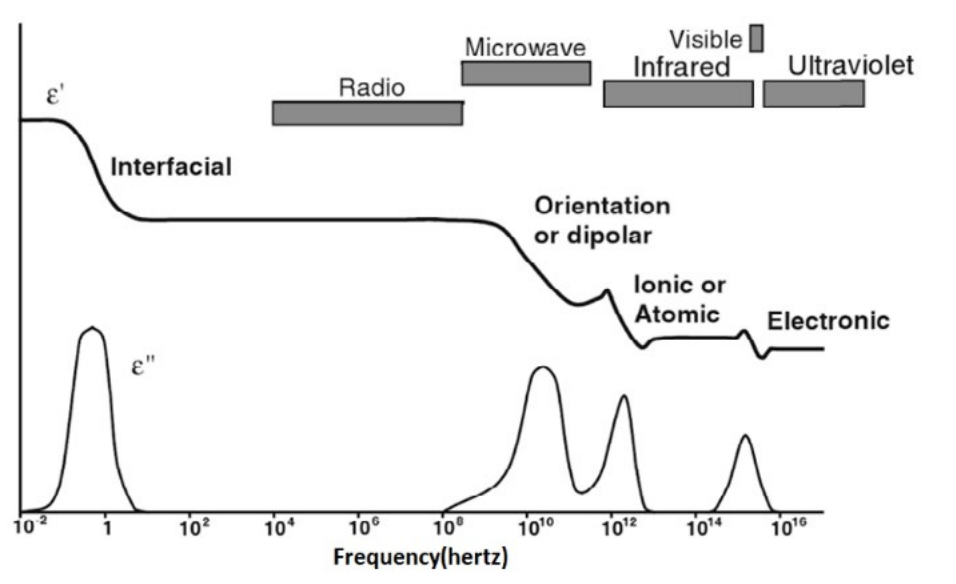
Figure 7: Frequency-Dependent Polarization (Source: Gupta and Wong Wai Leong [18]).
TEMPERATURE DEPENDENCE ON POLARIZATION
Temperature influences a material’s polarization. Molecules have some energy that produces random molecular motion. Because there is an equivalent amount of random motion in all directions, the net molecular motion is neutral. When a material with polar molecules is subjected to an external electric field, the molecules will try to align themselves in the direction of the applied electric field. However, if the material temperature is raised, the internal molecular motion increases, and the alignment with the applied electric field becomes more difficult. The orientational polarization is less, so the dielectric constant is also less [5].
CONCLUSIONS
Intrinsic material properties play a major role in how those materials appear in SAR imagery. Since the properties are inherent to all natural materials, it becomes important to understand not only the reactions of material to certain frequencies but also the electrophysical driving forces in play. The relative roughness or smoothness of a surface has a major effect on SAR appearance when considering EM wavelength. The temperature of the interrogated material is another important consideration because as temperature increases, the dielectric constant (relative permittivity) decreases. As the permittivity (resistance to setting up an electric field) increases, the dielectric constant increases. Molecular polarization affects EM energy absorption and, thus, its measured SAR return. As this article demonstrates, great care must be taken to account for all of these material properties and their influence on SAR imagery data.
ACKNOWLEDGMENTS
The author thanks Dr. Steven Price, Associate Professor, Mississippi College, Electrical Engineering, and Mr. Clay Blount, Research Chemical Engineer, Survivability Engineering Branch, Geotechnical and Structures Laboratory (GSL), U.S. Army Engineer Research and Development Center (ERDC), for their review and helpful comments on earlier drafts of this article.
REFERENCES
- Mini Physics. “The Electromagnetic Spectrum.” https://www.miniphysics.com/electromagnetic-spec-trum_25.html, accessed July 2019.
- Wolff, C. “Radar Basics.” http://www.radartutorial.eu/20.airborne/ab07.en.html, accessed July 2019.
- Radar and Electromagnetic Spectrum. “Types of Images.” http://slideplayer.com/slide/4403225/14/images/12/Radar+and+the+Electromagnetic+Spectrum.jpg, accessed 17 September 2018.
- Al-Ghamdi, A. A., O. A. Al-Hartomy, F. R. Al-Solamy, N. Dishovsky, D. Zaimova, R. Shtarkova, and V. Iliev. Scientific Research. “Some Factors Influencing the Dielectric Properties of Natural Rubber Composites Containing Different Carbon Nanostructures.” https://www.scirp.org/journal/PaperInformation.aspx?PaperID=64056, accessed 12 October 2018.
- University of Cambridge. “Effect of Temperature on the Dielectric Constant.” https://www.doitpoms.ac.uk/tlplib/dielectrics/temperature.php, accessed 18 October 2018.
- Natural Resources Canada. “Target Interaction and Image Appearance.” https://www.nrcan.gc.ca/node/9311, accessed 22 October 2018.
- Papathanassiou, H. K. Earth Online. “Rough Surface Scattering Models,” https://earth.esa.int/documents/653194/656796/Rough_Surface_Scattering_Models.pdf, accessed 23 October 2018.
- Earth Online. “Radar Course 2.” https://earth.esa.int/web/guest/missions/esa-operational-eo-missions/ers/instruments/sar/applications/radar-courses/content-2/-/asset_publisher/qIBc6NYRXfnG/content/radar-course-2-parameters-affecting-radar-backscatter, accessed 6 November 2018.
- Charvat, G. L. “Radar Imaging in Your Garage: Synthetic Aperture Radar.” https://hackaday.com/2014/03/17/radar-imaging-in-your-garage-synthetic-aperture-radar/, 17 March 2014.
- electronicsnotes. “Dielectric Constant & Relative Permittivity.” https://www.electronics-notes.com/articles/basic_concepts/capacitance/dielectric-constant-relative-permittivity.php, accessed 6 November 2018.
- Wikipedia. “Permeability (Electromagnetism).” https://en.wikipedia.org/wiki/Permeability_(electromagnetism), accessed 6 November 2018.
- Learn EMC. “Shielding Theory.” https://learnemc.com/shielding-theory, accessed 5 December 2018.
- Chemistry 301: University of Texas. “Polar Bonds.” https://ch301.cm.utexas.edu/section2.php?target=imfs/polar/polarbonds-all.php, accessed 5 December 2018.
- Schneider, H. J. “Ionic Interactions in Supramolecular Complexes.” In Ionic Interactions in Natural and Synthetic Macromolecules, edited by A. Ciferri and A. Perico, Wiley Online Library, 2012, https://onlinelibrary.wiley.com/doi/abs/10.1002/9781118165850.ch2, accessed 11 February 2019.
- Clark, J. Chemistry LibreTexts. “Metallic Bonding,” https://chem.libretexts.org/Bookshelves/Physi-cal_and_Theoretical_Chemistry_Textbook_Maps/Supple-mental_Modules_(Physical_and_Theoretical_Chemistry)/Chemical_Bonding/Fundamentals_of_Chemical_Bonding/Metallic_Bonding, accessed 11 February 2019.
- Wikipedia. “Fluid Mechanics for Mechanical Engineers/Introduction.” https://en.wikiversity.org/wiki/Fluid_Mechanics_for_Mechanical_Engineers/Introduction, 15 May 2019.
- Wikipedia. “Polarization Density.” https://en.wikipedia.org/wiki/Polarization_density, accessed 11 February 2019.
- Gupta, M., and E. Wong Wai Leong. “Introduction to Microwaves. In Microwaves and Metals, Singapore: John Wiley & Sons (Asia) Pte Ltd., 2007, https://books.google.com/books?d=nx6N4dq7zJgC&pg=PA38&lpg=PA38&dq=calculate+frequency+dependent+conduction+loss+in+materials&source=bl&ots=xrpKzUmoD6&sig=DiKCZe7LdtAPWYoBQzZ66VS85lA&hl=en&sa=X&ved=0ahUKEwjptc6hhLrYAhUPON8KHQM3CSIQ6AEIYDAJ#v=onepage&q=calculate%20frequency%20dependent%20conduction%20loss%20in%20materials&f=true, accessed 19 February 2019.
- Asztalos, K. “Design and Development of a Nasal Inhaler.” Armour College of Engineering, Illinois Institute of Technology, https://www.researchgate.net/publication/317701554_Design_and_Development_of_a_Na-sal_Inhaler, 29 April 2016.
- University of Cambridge. “The Dielectric Constant.” https://www.doitpoms.ac.uk/tlplib/dielectrics/dielectric_constant.php, accessed 19 February 2019.
BIOGRAPHY
QAISAR MANZOOR is a member of the Unconventional Countermeasures team at GSL, ERDC. His research focuses on understanding the interactions between electromagnetic radiation and material properties on SAR, IR, and multispectral imaging. As a veteran of the U.S. Armed Forces, he served in the U.S. Navy, Army, and Army Reserve. Mr. Manzoor completed his B.S. in physics, with a second major in mathematics from The University of Memphis. He is currently pursuing his master’s degree in applied physics from Johns Hopkins University, MD.


